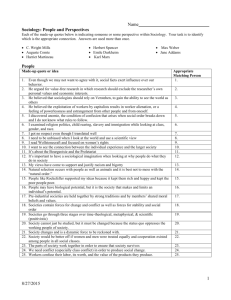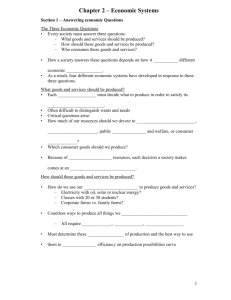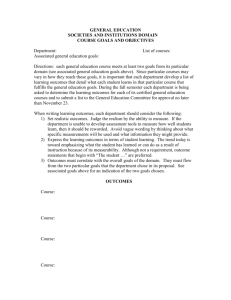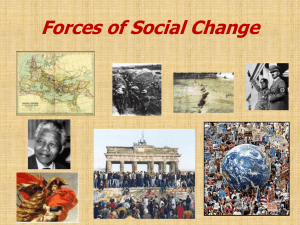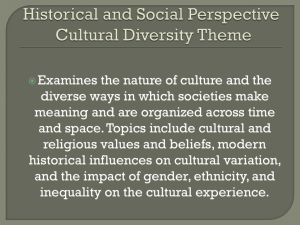120class&exploit
advertisement
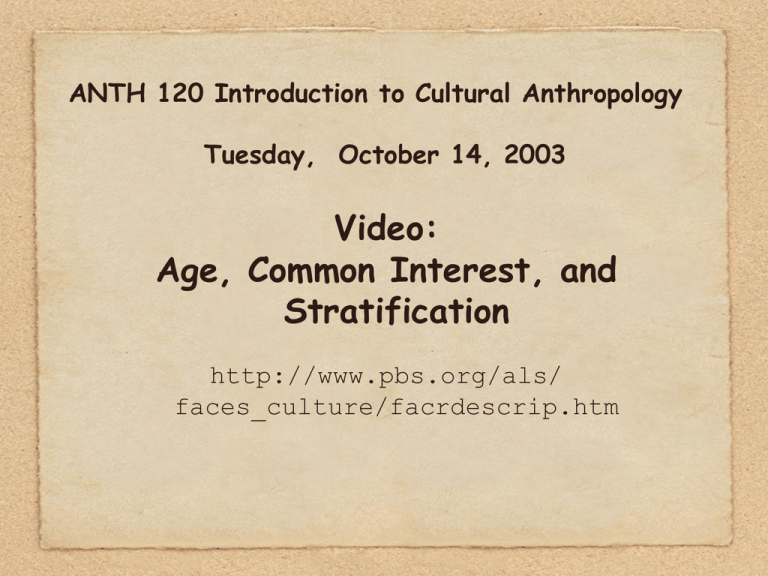
ANTH 120 Introduction to Cultural Anthropology Tuesday, October 14, 2003 Video: Age, Common Interest, and Stratification http://www.pbs.org/als/ faces_culture/facrdescrip.htm Comments on Video 1. Criticism of cultural relativist approach to stratification 2. Berremen on stratification Berremen on stratification Berreman, G. D. (1981). Social Inequality: A Cross-Cultural Analysis. Social Inequality: Comparative and Developmental Approaches. G. D. Berreman. New York, Academic Press. pp. 3-4 I believe that stratification . . . is pernicious: It is humanly harmful in that it is painful, damaging, and unjust, and it is consistently experienced as such by those who are deprived and oppressed. . . . It is responsible for hunger even when there is plenty, for high mortality, high fertility, and low life expectancy, for low levels of education, literacy, political participation, and other measures of the quality of life . . .. Berremen on stratification (2) Stratification is also dangerous in that the poverty, oppression, hunger, fear, and frustration inherent in it result in resentment among the deprived and anxiety among the priveleged, with the result that overt, perhaps catastrophic, conflict is inevitable. Much of the source of crime in the street, terrorism, ethnic conflict, civil war, and international war is inequality so organized and the alarm, repression, and competition it engenders . . . Inequality between peoples and nationals is a major hreat to societal and even human survival. Berremen on stratification Berreman, G. D. (1981). Social Inequality: A CrossCultural Analysis. Social Inequality: Comparative and Developmental Approaches. G. D. Berreman. New York, Academic Press. pp. 3-4 Thermodynamic analysis Review discussion of social thermodynamics Communal Societies Characteristics of Communal Societies • social order of hunters and gatherers and many horticultural societies • usually small populations with geographic mobility • an equal obligation to labor, mostly in food production • hours of labor about half of modern societies, about 1000 hours per year • division of labor by age and sex Characteristics of Communal Societies • equal access to the social product, with equal sharing of the product of human labor, especially food • equal assess to violence; no coercive institutions such as police, armies, courts, prisons, etc. • equal access to the sacred and supernatural [shamans, communal religion] Characteristics of Communal Societies • • • • • negative features include high infant mortality, low life expectancy, disease, homicide most frequent cause of male deaths, low level of development of forces of social production Characteristics of Communal Societies Using the categories of the textbook, • bands and tribes are both forms of ancestral communism. • Chiefdoms are transitional between ancestral communism and class rule. • States are systems of class rule. Class Ruled Societies Class Ruled Societies • • • • • the social order found in the historic agrarian civilizations and in modern industrial societies population divided into two, with differential access to the social product the social product is divided into two: the necessary product, made of of the means of production and the goods and services consumed by the direct producers, and the surplus, consumed by the ruling class the producing classes, or the direct producers, put their labor energy into productive system hours of labor about twice that of classless societies, about 2000 hours per year Class Ruled Societies • • • the ruling class put their time and energy into the system of exploitation which has three components: [1] exploitative techniques, such as plunder, slavery, rent, tribute, and unequal exchange; [2] violence, or the State; and [3] thought control, or the Church exploitation and surplus value • Exploitation is the forcible extraction of surplus from the direct producers by a class of non-producers. It is an objective social process which can be measured independently of the moral judgment of the observer or the subjective feeling of the exploited. The State • The State is a social organization controlled by the ruling class which has an effective monopoly of legitimate violence. Its primary function is to protect the property system supporting the ruling class from internal and external threats, and hence, protect the wealth and privileges of the ruling class. It also carries out socially necessary functions, such as maintaining roads and irrigation systems and controlling education. The Church • The Church is a social organization which controls access to the sacred and supernatural through a priesthood. It is also controlled by the ruling class and is used to legitimate the wealth and privileges of the ruling class and the violent activities of the State. Class Ruled Societies • • all systems of class rule are also patriarchal since men are the chief beneficiaries of the system and also tend to occupy the chief positions in the State-Church bureaucracies, and women are the worst, but not the only, victims of the system the underlying class division between rulers and ruled is complicated by an elaboration of intermediate classes and gradations within the classes. Class Ruled Societies • class: Marxist and bourgeois conceptions • class struggle and revolution That’s all for today! ANTH 120 Introduction to Cultural Anthropology Thursday, October 16, 2003 Video: Political Organization Notes on Video bands, tribes, chiefdoms and states !Kung, the Mendi, and the Kpelle theocratic government of Tibet The State • An organization within society that has a monopoly of legitimate violence • Protects the wealth and privileges of the ruling class Marx on the State There have been in Asia, generally, from immemorial times, but three departments of Government: that of Finance, or the plunder of the interior, that of War, or the plunder of the exterior; and finally, the department of Public Works. (Marx 1853a:90). Traditional and Modern States • Traditional states - political office based on birth, religious basis of legitimacy • Modern states - elections, human rights Imperialism • • • The direct or indirect rule over foreign areas by a state or empire Spanish, British, French and German empires, the American Empire Neo-colonialism - economic and social control that is maintained after nominal political independence is granted Domhoff, G. W. (2002). Who Rules America? Power and Politics in the Year 2000. Englewood Cliffs, NJ, Prentice-Hall. 1. Controls the American economy through its ownership of corporate stock and by occupying key positions on the boards of directors in management of major industrial and financial institutions (co-optation) 2. Controls the American political system through its financing of campaigns for both the Republican and Democratic parties and by occupying key positions in the government 3. Controls the mass media both through direct ownership and through advertising. 4. Controls education through its control over the major universities and research foundations (such as the Ford and Rockefeller Foundations). President Woodrow Wilson The masters of the government of the United States are the combined capitalists and manufacturers of the United States. … The government of the United States at present is a foster-child of the special interests. It is not allowed to have a will of its own. ANTH 120 Introduction to Cultural Anthropology Tuesday, October 21, 2003 Video: Religion and Magic Notes on Video • • • • • American Indians and animism (medicine mask) Maya & syncretism Eka Dasa Tudra ritual of the Balinese Hare Krishnas in Los Angeles Revitalization movements (Mormons) Religion and the Church • Religion is a cultural universal that exists in all societies • The Church is a social organization that uses religion for social control to support the ruling class Marx on religion The basis of irreligious criticism is: Man makes religion, religion does not make man. In other words, religion is the self-consciousness and self-feeling of man . . . Marx on religion Religious distress is at the same time the expression of real distress and the protest against real distress. Religion is the sigh of the oppressed creature, the heart of a heartless world, just as it is the spirit of a spiritless situation. It is the opium of the people. Marx on religion The abolition of religion as the illusory happiness of the people is required for their real happiness. The demand to give up the illusions about its condition is the demand to give up a condition which needs illusions. The criticism of religion is therefore in embryo the criticism of the vale of woe, the halo of which is religion. Marx on religion Criticism has plucked the imaginary flowers from the chain not so that man will wear the chain without any fantasy or consolation but so that he will shake off the chain and cull the living flower. More on religion Two interpretations of term, “opiate” Additional functions of religion Additional comments on class All class systems are also systems of patriarchy Complexity of class systems Class Ruled Societies • • all systems of class rule are also patriarchal since men are the chief beneficiaries of the system and also tend to occupy the chief positions in the State-Church bureaucracies, and women are the worst, but not the only, victims of the system the underlying class division between rulers and ruled is complicated by an elaboration of intermediate classes and gradations within the classes. Class Ruled Societies • class: Marxist and bourgeois conceptions • class struggle and revolution That’s all for today!



